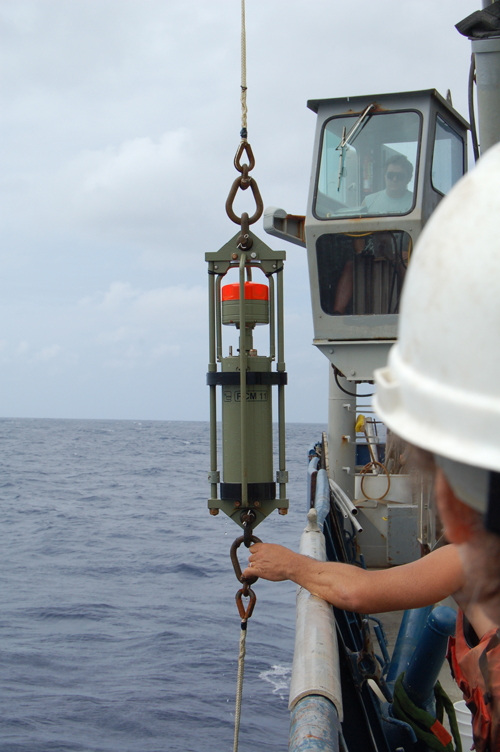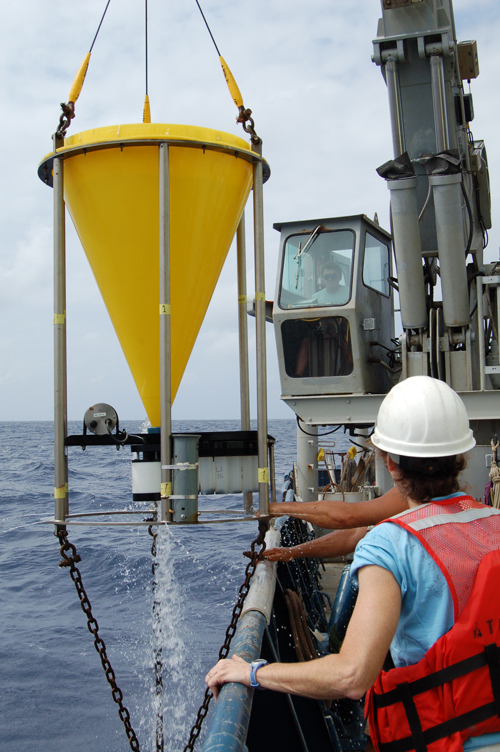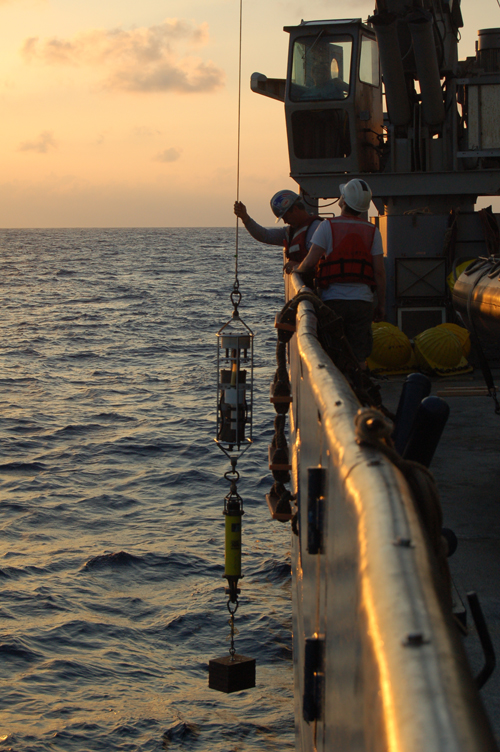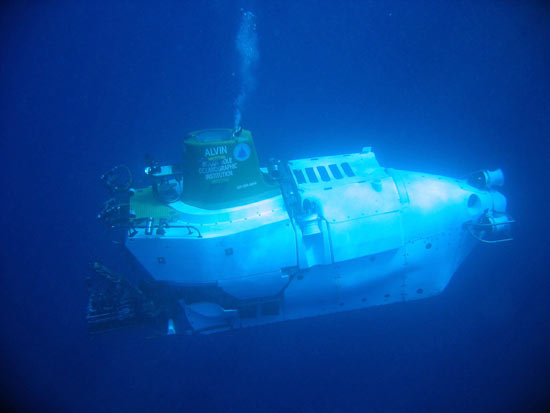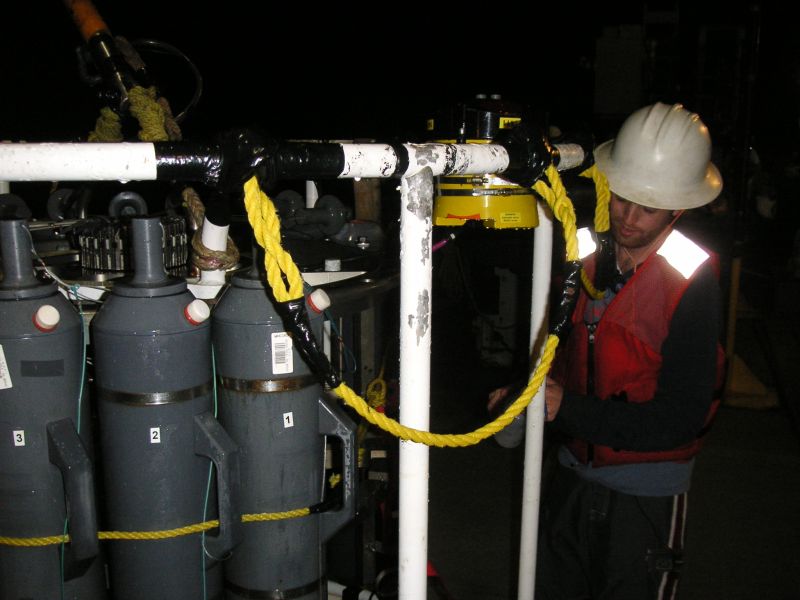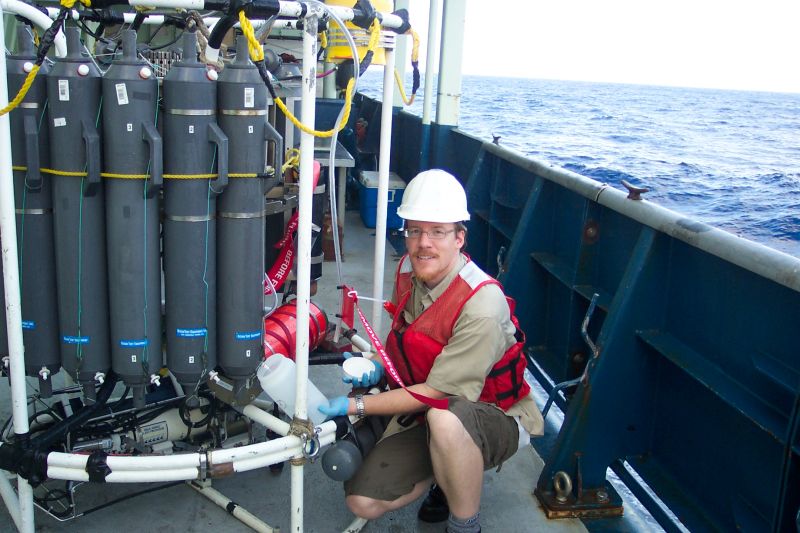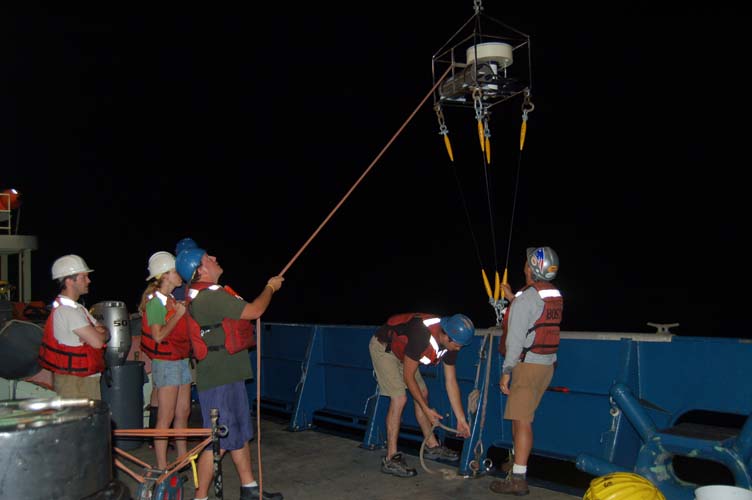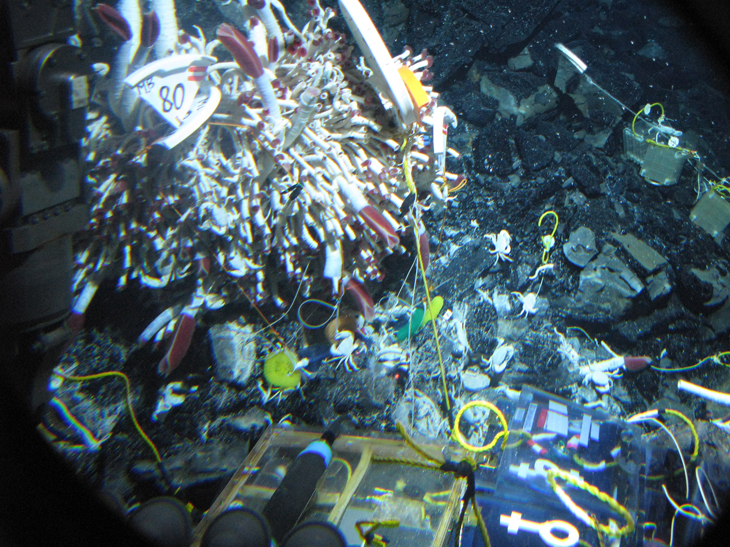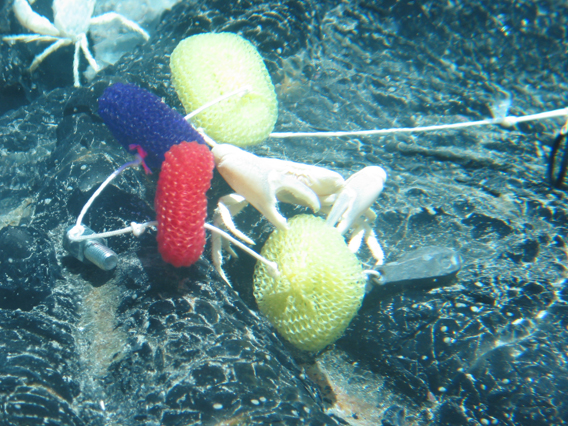What is LADDER all about?
LADDER stands for LArval Deep Dispersal on the East Pacific Rise. This is the third of three LADDER cruises. PIs: Lauren Mullineaux (WHOI), Andreas Thurnherr (LDEO), Jim Ledwell (WHOI), Dennis McGillicuddy (WHOI) and Bill Lavelle (NOAA/PMEL). The project is funded by NSF Grant OCE-0424953. (Visit here for more details.)
The main objective of LADDER III is to answer the following questions:
Bio-1) What are the influences of advection and eddy diffusion on the maximal dispersal distance of vent species with given larval life spans?
Bio-2) What are the effects of ontogenetic changes in larval behavior (i.e., vertical positioning) on species' dispersal distances?
Bio-3) How are the probabilities that larvae will be lost from the ridge system influenced by topography and flow? Might the axial summit trough inhibit off-axis transport of larvae, and serve as a conduit between habitable vent sites?
PO-1) What are the mean and temporally varying flows in the vicinity of a mid-ocean ridge crest, and what is their spatial structure and coherence?
PO-2) What is the magnitude of the diapycnal diffusivity near the ridge crest?
PO-3) How rapid is lateral dispersion, and how effective is lateral homogenization by eddy diffusion near the ridge crest?
1) Recovery of Mooring Array. Seven moorings equipped with 15 current meters, 2 velocity profilers and 3 sediment traps will be recovered from a cross-shaped array centered on the EPR crest at 9:30N. Three axial moorings were positioned within the axial trough between 9:10 and 9:50N; a cross-axial mooring line was deployed at 9:30N between 103:55 and 104:35W. The moorings collected data between 2000 and 2900m.
Current meter being recovered. Photo by Skylar Bayer.
2) CTD/LADCP profiling. An extensive survey will be carried out at night, and occasionally during daytime, both along the EPR axis and on the flanks.

Station map for LADDER III cruise. The colors on the map indicate meters below sea-level. You can see that the average depth of the Ridge is 2500 meters below sea-level (mostly orange). The red in the upper left quarter of the map indicate seamounts. (Image: Andreas Thurnherr)


Left: Angel Ruiz Angulo working on the CTD. Right: Xinfeng Liang with CTD tagline. (Photos: Andreas Thurnherr)
3) Microstructure profiling. A survey using a deep microstructure profiling system (DMP) will be coordinated with the CTD/LADCP deployments, to be carried out at night, and occasionally during daytime, along the EPR axis and on the flanks. This is part of a separate project (described below) with PIs Andreas Thurnherr and Louis St Laurent.
The DMP in its cradle. Photo by Matthew Schwartz.
4) Recover larval sediment trap moorings. Two short moorings with sediment traps will be recovered from a site near 9-50(TrapL1, S of Ty/Io vent, near NA) and near 9-30 (TrapL2, near CA). These were used to monitor temporal variation in larval supply to the vent sites.
Sediment trap being recovered. Photo by Susan Mills.
5) Deploy and recover plankton-pump moorings. Pairs of moorings will be deployed along the ridge axis, with one near and the other away from an active vent community. Each mooring will support two plankton pumps, one near-bottom (4 mab) and the other at the level of the neutrally-buoyant plume. Four sets of pairs will be deployed over the course of the cruise, each for a ~2-day interval. The samples will be used to quantify larval abundances with respect to potential barriers to dispersal (e.g., the axial summit trough walls, or lateral offsets in the ASCT) and distance from potential source populations.
Plankton pump being deployed. Photo by Susan Mills.
6) Monitor colonization on the seafloor. Colonization experiments will be conducted with basalt blocks and plastic sandwiches placed on the seafloor at active vent sites. We will recover experiments from Dec. 2006 and set out new ones. Our main focus will be on the diffuse-flow communities.
Recruitment sandwich with many vestimentiferans (tubeworms) growing inbetween the plates. Photo by Skylar Bayer.
The Mullineaux group (WHOI)
Lauren Mullineaux (WHOI), Susan Mills (WHOI), Carly Strasser (WHOI), Ben Walther (University of Adelalide), Nica Staglicic (Institute of Oceanography and Fisheries of Croatia), Skylar Bayer (Brown University)
Left to right: Chip, Carly and Ben (by Skylar Bayer); Nica & Lauren (by Susan Mills), Ben & Susan (by Skylar Bayer), Alvin (from WHOI).
The WHOI mooring team
Brian Hogue (Left) & Paul Fraser (Right)
Photo by Skylar Bayer.
Vertical Mixing near the crest of the EPR (PIs: Andreas Thurnherr and Louis St. Laurent) This project is funded by NSF Grant OCE-0727402.
Andreas Thurnherr (LDEO), Louis St. Laurent (FSU), Angel Ruiz-Angulo (LDEO), Xinfeng Liang (LDEO), Eric Howarth (FSU), Ken Decoteau (FSU)


Left: Louis St. Laurent, Ken Decoteau, Eric Howarth. (Photo: Skylar Bayer) Right: Amy Simoneau (SSSG), Angel Ruiz-Angulo and Xinfeng Liang deploying CTD. (Photo: Andreas Thurnherr)
In spite of several decades of research, mixing in the deep ocean remains poorly characterized. In particular, all available data on which current roughness-based mixing measurements are based, were taken on slow-spreading ridges where different processes have been implicated in the observed high levels of mixing. Therefore, it is entirely unknown to what degree these mixing measurements apply on fast-spreading ridges.
Our sampling program consists of examining both the microstructure and finestructure of ocean mixing. Miscrostructure is on a scale of centimeters to millimeters and finestructure is on the scale of meters. The Microprofiler measures the turbulence and mixing rates on the microstructure scale and the lowered acoustic Doppler profiler measures those of the finestructure. This will yield direct estimates of turbulent dissipation rates and finestructure parameters.
Left to Right: The Microprofiler (DMP) being loaded. Grad student Jon Stewart and the LADCP. Photos by Matthew Schwartz.
The microstructure survey is the first to characterize dissipation levels at any fast-spreading ridge site and will thus significantly extend the available mixing data set from the deep ocean to sites with different topographic characteristics. The measured dissipation rates will be used to improve mixing measurements to be used in circulation and climate models.
Water column denitrification (PI: Schwartz)
Matthew Schwartz & Jonathan Stewart (University of Western Florida)
I am collecting water samples from the portion of the water column known as the oxygen deficit zone. This region is about 500-900 m below the ocean surface and is marked by a significant decrease in dissolved oxygen concentrations due to respiration of organic matter (OM) in the form of phytoplankton and such from the shallow, photic water column.
One of the ways that OM is consumed is via a process called denitrification in which nitrate (NO3) is transformed in dinitrogen gas (N2). I am collecting water column samples and will analyze them at the University of West Florida in Pensacola, FL, to determine the concentrations of inorganic nutrients (including nitrate) and dissolved N2. This will allow me to see just how much denitrificaton is occurriing in these waters and if the mixing between various oceanic water masses in this region of the eastern tropical north Pacific alters the rate of denitrification.
This research overlaps with other research that I conduct in estuaries and coastal environments the Pensacola, FL, region of the Gulf of Mexico.
Matt Schwartz sampling from the CTD. Photo provided by Matthew Schwartz.
Suspended Particle Rosette (SUPR) Sampler for Investigating Hydrothermal Plume Particulates (PI: Breier)
Chip Breier (WHOI AOP&E), Brandy Toner (currently WHOI MC&G, very soon Univ. of Minnesota), Chris German (WHOI MG&G)
This is the first at-sea deployment of a new oceanographic tool, a suspended particulate rosette (SUPR) sampling system capable of rapidly filtering 25 large water volume samples (> 100 liters per sample) for suspended particulates during a single CTD cast or moored deployment. In addition to being able to rapidly collect many samples at a time, I designed the SUPR sampler to be compatible with in situ optical analysis techniques we are currently developing back in the laboratory. Being able to collect samples when and where we choose, and eventually being able to carry out a portion of the analysis underwater in their natural environment, will allow us to investigate these fundamental questions,
“How do iron- and manganese-rich, hydrothermal plume particles affect seawater chemistry and to what extent do these particles fuel microbial activity in deep-sea hydrothermal plumes?”
Chip, Carly, Ben, Brian (OS), Ronnie (OS) and Patrick (Bosun) deploying the SUPR for the first time. Photo by Lauren Mullineaux.
The samples we are collecting now at EPR will allow us to take an unprecedented look at spatial variability in the mineralogy and biogeochemistry of non-buoyant hydrothermal plume particles – using a combination of laser Raman, micro-scale x-ray absorption spectroscopy, and bulk and trace elemental analysis.
Hydrothermal Vent Meiobenthos (PI: Bright)
Monica Bright, Sabine Gollner & Ingrid Kolar (University of Vienna)
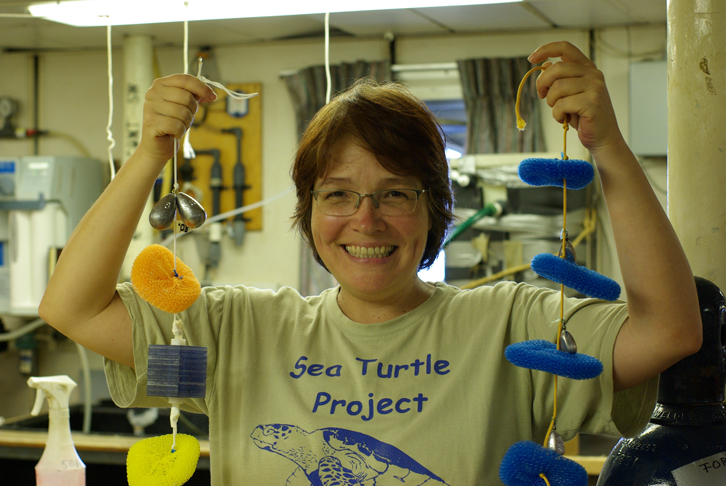
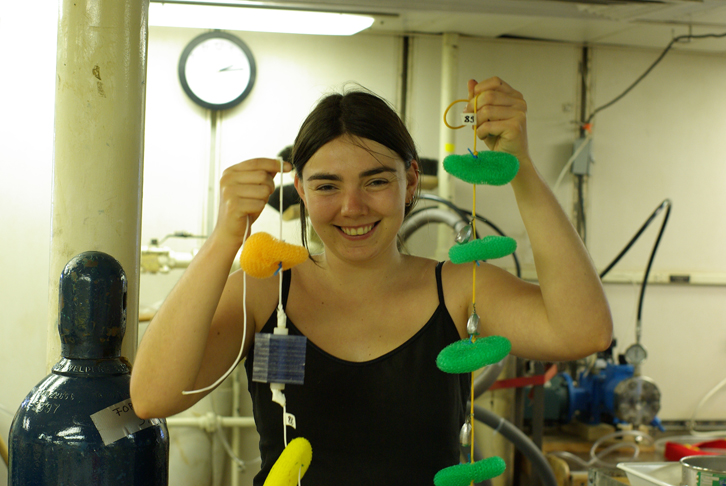
Left: Ingrid Kolar. Right: Sabine Gollner. Photos by Xinfeng Liang.
Deep-sea hydrothermal vents are globally wide-spread extreme environments located at the mid-ocean ridge system of the largest mountain chain on Earth. Driven by in situ primary production via chemosynthesis, a special vent fauna thrives under highly fluctuating conditions along a gradient of temperature and toxic chemicals such as hydrogen sulfide.
Meiofauna (the small-sized animal and protist community) of the 9o50' N EPR region is a prominent component of all known vent communities there and has been found in low diversity and low abundance. As the volcano of this region erupted in early 2006 and destroyed most of the organisms living there, we have the unique opportunity to study the sofar completely unknown successional patterns of meiobenthos.
Settlement experiment site. Some of the artificial surfaces seen in yellow and green. At the bottom of the picture is the Alvin basket with the austrian Bioboxes on the right. (WHOI Alvin group/LADDER I cruise)
Using artificial settlement devices and control natural collections in a variety of benthic locations with and without vent flux in the axial summit collapse trough, as well as in the pelagial on moorings, we will investigate the temporal and spatial hydrothermal vent communities over a time course of about 6 months to 3 years post eruption.
Close up of yellow, blue and red settlement surfaces (basically brillo pads/sponges). (WHOI Alvin group/LADDER I cruise)
This study on succession, the non-seasonal, directional continuous pattern of colonization and extinction will include the description of new species, the identification, and quantification of the specific meiofauna communities of selected hydrothermal vent habitats in terms of species richness, diversity, and abundance in conjunction with an assessment of the abiotic conditions as well as of the bacterial abundance and particulate organic matter measurements serving as food for this exclusively primary consumer community.
In addition, this study will include the search for vent meiobenthic species in the pelagial in the vicinity the 9o50' N EPR region. This study will be the first of its kind and will lead to a better understanding of the processes and underlying mechanisms of vent meiofauna succession.
This is Atlantis Cruise 15-26
Our main study site is 9 50' N on the East Pacfic Rise (image provided by Susan Mills)
The EPR is a fast-spreading ridge (lots of volcanic activity)
![]() Bathymetry of the study site (image provided by Chip Breier)
Bathymetry of the study site (image provided by Chip Breier)
![]() PDF of bathymetry of the EPR (image provided by Angel Ruiz Angelo)
PDF of bathymetry of the EPR (image provided by Angel Ruiz Angelo)
CTD: This device measures Conductivity, Temperature and Depth and collects water samples in Niskin bottles from various depths.
LADCP: Lowered Acoustic Doppler Current Profiler. This device uses acoustic waves to determine velocities in the ocean.
Sediment Trap: Collects particles and larvae moving downward.
Plankton Pump: pumps a certain volume of seawater for a certain amount of time catching anything usually between a centimeter and 63 microns.
PO: Physical Oceanography.
PI: Principle Investigator.
Fauna: animals.
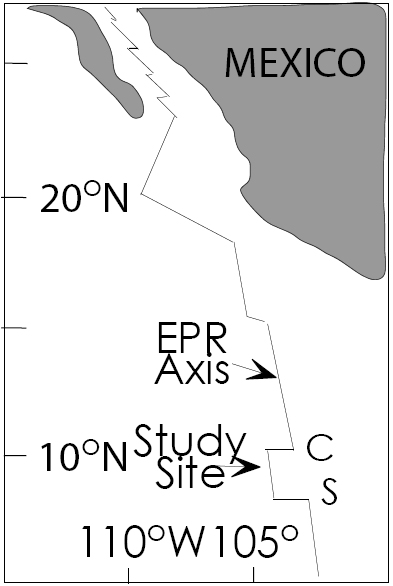
http://venturedeepocean.org/expeditions/epr/
Photographic Identification Guide to Larvae at Hydrothermal vents in the Eastern Pacific
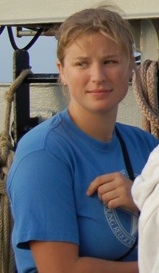
My name is Skylar Bayer, I'm a Brown University undergraduate senior concentrating in marine biology. I worked in the Mullineaux lab this previous summer (2007) as a Summer Student Fellow.
I'm a cruise participant in the science party aboard the Atlantis 15-26 cruise (November 13th - December 3rd 2007).
The purpose of this site is to provide students at high schools in the Westford, MA area, Middlesex high school, and Groton High School with an idea of what oceanographic research is like from a scientist and student's perspective.
This webspace is provided for by WHOI. 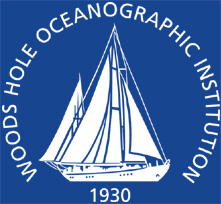
If you have any questions, please contact me.
